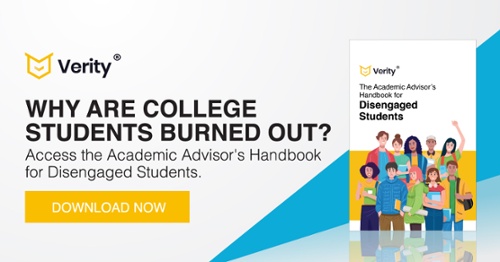Ask an Expert: Why Students Transfer to Other Schools
One of the biggest challenges facing the Higher Ed industry right now is the fact that retention rates are down across the board.
Whether it’s because students are transferring or dropping out of college altogether, this is a hot-button issue for all of us who work in Higher Ed.
But, why do students transfer to other schools?
As someone who’s spent most of her career in Higher Ed, including in a Director of Admissions role for seven years, this is a question that I know gets asked a lot.
First, it’s important to recognize that students today face more challenges than they did in the past. Between higher costs of living, stress and anxiety, the academic disruptions caused by the pandemic, and technology and social media constantly fighting for their attention, college student burnout is at an all-time high. While many students are dropping out altogether, there are many others who are transferring to other schools looking for a fresh start.
It’s also important to acknowledge that transferring is now easier than ever. What used to be a complex and cumbersome process can now be done—more or less—at the click of the button.
When you combine these two factors, it’s no wonder that so many students are transferring.
Most schools are prioritizing admissions and new student acquisition, but too few are focusing enough on student retention. We cover this in-depth in our blog post, What the Research Tells Us About College Student Retention.
Schools that do recognize the importance of prioritizing retention have higher program success rates and healthier organizations. These schools also do a great job of proving the value of their education they provide, which not only helps sets the students’ minds at ease but creates confidence in the education they’re receiving and the gainful employment that awaits them upon graduation.
In this blog, we’ll cover why students transfer, how to increase student retention, and how to leverage technology that can support your efforts.
Why College Students Transfer to Other Schools
One of the biggest reasons for students dropping out or transferring comes from dealing with the challenges we listed above, which can create a great amount of stress, anxiety, and depression for college students.
Financial challenges is another issue that many students and their families are coping with, being unable to keep up with rising tuition costs. When students are struggling and stressed about keeping up with payments, their day-to-day challenges can really pile up. One skipped lecture becomes two and three. Falling behind on assignments starts to snowball. Suddenly, students can fall way behind and it can feel impossible to catch up.
There is also a domino effect that comes with students transferring, in which one transfer can spark several others. When a student sees one or two of their friends leaving for another school, they start to think about their own experience. Am I getting what I need? Is this the right place for me? Would I do better at another school?
Seeing their friends transfer can raise questions in a student’s mind, which can often compel them to explore other opportunities as well.
One of the common misconceptions that I’ve seen so many Higher Ed professionals fall for is thinking that students that are skipping classes and falling behind on coursework because they don’t want to be there. Instead, the staff and faculty shift their focus and energy toward the students who do want to be there.
Don’t let this be you!
Keep these things in mind:
- Every student wants to be there, otherwise they wouldn’t have enrolled in the first place
- Each student has different challenges, and many of them have personal issues, come from broken homes, or are struggling to make ends meet.
- Everyone handles challenges differently. It is not for us to judge.
- It’s important to have empathy and give students the greatest chance to succeed, which will vary from student to student.
How to Increase Retention Rates at Your Higher Ed Institution
So, how can your institution increase retention rates when so many other schools are facing these challenges?
Here are a few ways to get started.
1. Create a Strong Sense of Community
Creating a sense of community is much easier when you have students on campus attending class in person. But, what about the increase of online and hybrid classes?
As virtual learning becomes more and more popular, it’s critical to give students the opportunities to make new friends, stay connected with each other, and not feel isolated by the lack of in-person experiences.
There are many ways to foster that sense of community for online students, such as virtual events and meet-and-greet mixers on your campus or at a popular bar or restaurant. One of methods that I’ve seen be the most impactful is to make sure that the faculty are creating assignments that require students to work together so that they can collaborate and cooperate even in a remote environment.
6 Things Every College Student Needs from their University
2. Recognize the Early Signs that a Student Might Transfer
There are many signs that a student is about to transfer or drop out, such as lack of focus, missing assignments, tardiness, poor grades, absenteeism, etc.
As we cover in our guide, The Higher Ed Handbook for Disengaged Students, recognizing these signs early and acting on them is the first step toward building deeper relationships with your students and increasing retention rates.
I also recommend that schools make sure that they place some of their best, most passionate professors in entry-level courses so students can get excited, buy in early, and build good habits right from the beginning.
3. Be Proactive with Student-Focused Solutions
Building on the idea of recognizing these signs early, it’s important to have solutions in place that help students get back on track.
Instead of having to worry about rising transfer rates, you can avoid it altogether by building a solid foundation of student-focused solutions in place from the beginning.
For example, with workflow automation software, you can set up internal alerts that get triggered when students miss a certain number of classes or homework assignments and then notify the Academic Advisor so that they can meet with the student and figure out what’s going on.
It’s important that everyone at the institution helps to address this important challenge, including counselors, advisors, resident life, admissions, faculty, and more.
Using Software to Build Your Student Retention Strategy
Increasing student retention can be challenging, but it’s a lot less challenging when you have the right tools in place.
A CRM solution like Verity Dialog has marketing automation and other tools that Higher Ed professionals are using for admissions, converting leads, engaging students, building relationships, and making data-driven decisions. See it for yourself.
You can also download The Higher Ed Handbook for Disengaged Students for advice on how to recognize the early signs of disengagement and how to build short- and long-term solutions that drive increased student retention.


